
|
Astronomy Picture Of the Day (APOD)
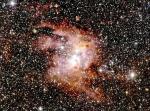 Giant Emission Nebula NGC 3603 in Infrared
Giant Emission Nebula NGC 3603 in Infrared
14.08.2002
NGC 3603 is the largest region of glowing gas in our Milky Way galaxy. Spanning over 20 light years across, the giant emission nebula (HII region) is home to a massive star cluster, thick dust pillars, and a star about to explode.
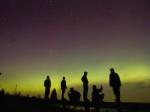 Contemplating the Sky
Contemplating the Sky
13.08.2002
Have you contemplated your sky recently? Last night was a good one for midnight meditators at many northerly locations as meteors from the Perseid meteor shower frequently streaked through. The Perseid meteor shower has slowly been building to a crescendo but should continue to be rewarding tonight and into the week.
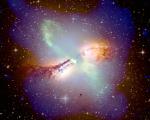 The Colors and Mysteries of Centaurus A
The Colors and Mysteries of Centaurus A
12.08.2002
Why is spiral galaxy Centaurus A in so much turmoil? The above composite image shows different clues to the unusual galaxy's past in different bands of light. In low energy radio waves, shown in red, lobes across the thick swath of dust glow brightly.
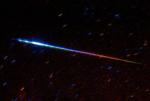 A Perseid Meteor
A Perseid Meteor
11.08.2002
The ongoing Perseid Meteor Shower should be at its strongest on August 12 and 13. The best time to watch will be between 2:00 AM and dawn on Monday morning (so plan on setting your alarm tonight!) and then again on Tuesday.
 Earth at Night
Earth at Night
10.08.2002
This is what the Earth looks like at night. Can you find your favorite country or city? Surprisingly, city lights make this task quite possible. Human-made lights highlight particularly developed or populated areas of the Earth's surface, including the seaboards of Europe, the eastern United States, and Japan.
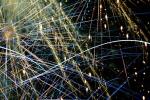 Fireworks and Shooting Stars
Fireworks and Shooting Stars
9.08.2002
Experimenting with a new telescope and camera, photographer Jim Steele captured this surreal but festive image of fireworks in the night sky above Ashland, Oregon. The date was July 4th and the fiery streaks were part of the traditional annual celebration of independence day in the United States.
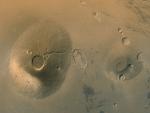 Ancient Volcanos of Mars
Ancient Volcanos of Mars
8.08.2002
Findings of ancient martian microbial fossils in meteorites and liquid water related features on Mars' surface are currently controversial issues. But one thing long established by space-based observations of the Red Planet is the presence of volcanos, as Mars supports some of the largest volcanos in the solar system.
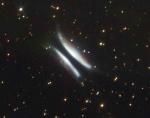 Gomezs Hamburger: A Proto Planetary Nebula
Gomezs Hamburger: A Proto Planetary Nebula
7.08.2002
What, in heaven, is that? Sometimes astronomers see things on the sky they don't immediately understand. In 1985 this happened to Arturo Gomez, and the object became known as Gomez's Hamburger for its distinctive yet familiar shape.
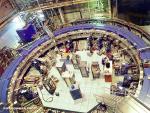 Muon Wobble Possible Door to Supersymmetric Universe
Muon Wobble Possible Door to Supersymmetric Universe
6.08.2002
How fast do fundamental particles wobble? A surprising answer to this seemingly inconsequential question is coming out of Brookhaven National Laboratory in New York, USA and may not only that indicate that the Standard Model of Particle Physics is incomplete but also that our universe is filled with a previously undetected type of fundamental particles
 Rays from an Unexpected Aurora
Rays from an Unexpected Aurora
5.08.2002
This aurora was a bit of a surprise. For starters, last Friday morning, no intense auroral activity was expected at all. Possibly more surprising, however, the aurora appeared to show an usual structure of green rays from some locations.
|
January February March April May June July August September October November December |
|||||||||||||||||||||||||||||||||||||||||||||||||